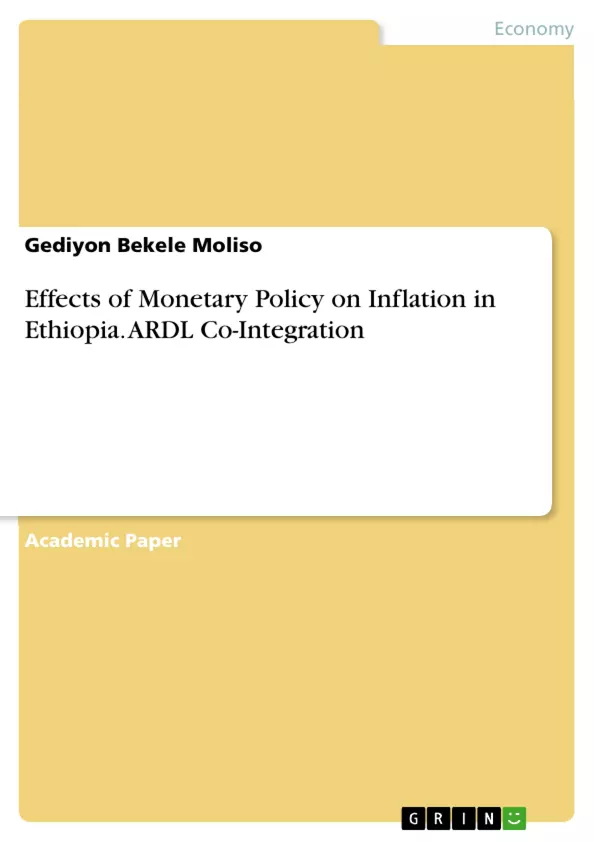The goal of this research is to close lack of sufficient, contemporary and comprehensive studies on the topic under study and gain a better understanding of the relationship between monetary policy and Ethiopian inflation.
The paper is organized as follows. After this introduction, the following section reviews the relevant literature, both theoretical and empirical. After this review, the methodological framework is presented. A series of test are show to assess the sensibility of the model. The discussion of the results is presented. Finally, some concluding remarks are shown.
The monetary policy pursued by a country's Central Bank has a significant impact on the country's economic and financial status. It is commonly acknowledged that maintaining price stability through monetary policy can contribute to long-term growth. When the rate of inflation is low enough, consumers and companies do not have to consider it when making daily decisions, according to Christiano and Fitzgerald.
The method, through which a country's monetary authority manages the supply of money, frequently by targeting an interest rate in order to promote economic growth and stability, is known as monetary policy. It is essentially a set of actions performed by monetary authorities, usually the central bank, to control and regulate the supply of money to the public as well as the flow of credit in order to achieve preset macroeconomic objectives.
Its stated objective is to maintain relatively steady pricing and low unemployment. All methods of monetary policy, in reality, require changing the amount of base currency in circulation. Open market operations are the open sales and purchases of (government-issued) debt and credit instruments that change the liquidity of the base currency. The monetary authority's constant market operations influence the supply of currency, which has an impact on other market variables including short-term interest rates and the exchange rate.
Inhaltsverzeichnis (Table of Contents)
- Abstract
- INTRODUCTION
- LITRATURE REVIEW
- Theoretical Review
- Empirical Review
- Methodology and Data Sources
- Data Source and Variable Definitions
- Variable Definitions and Expectations of sign
- Estimation Method
- Model Specification
- Stationarity Test
- Model Stability Check and Residual Diagnostic Test
- Autoregressive Distributed Lag (ARDL) Model
- Estimated Results and Interpretation
- Descriptive Analysis
- Unit Root Test
- Testing for Bounds Test or Co-Integration
- Long run model
- ARDL Short Run Estimate Output
- CONCLUSION AND POLICY IMPLICATIONS
- Conclusion
- Policy Implications
- Reference
Zielsetzung und Themenschwerpunkte (Objectives and Key Themes)
The primary objective of this study is to examine the influence of monetary policy on inflation in Ethiopia, utilizing annual time-series data from 1988 to 2021. The research employs the Autoregressive Distributed Lag (ARDL) approach to investigate the long-term relationship between these variables.
- The impact of monetary policy on inflation in Ethiopia.
- The role of various monetary policy tools, such as money supply, interest rates, and exchange rates, in shaping inflation.
- The long-term relationship between monetary policy variables and inflation.
- The speed of adjustment of inflation to its equilibrium level.
- Policy recommendations based on the empirical findings to address inflation challenges in Ethiopia.
Zusammenfassung der Kapitel (Chapter Summaries)
The introduction provides context for the study, highlighting the significance of monetary policy in influencing a country's economic and financial stability. It discusses the concept of monetary policy and its objectives, emphasizing the importance of price stability and low unemployment. It also explores the debate regarding the effectiveness of monetary policy in addressing inflation caused by cost-push factors.
The literature review chapter examines both theoretical and empirical research on the relationship between monetary policy and inflation. It explores various theories and models that have been proposed to explain this relationship, providing insights from previous studies conducted in different contexts.
The methodology and data sources chapter outlines the research methodology employed in the study. It details the data sources, variable definitions, and estimation methods used to analyze the relationship between monetary policy variables and inflation. The chapter also provides an overview of the Autoregressive Distributed Lag (ARDL) model and its application in the study.
The estimated results and interpretation chapter presents the findings of the empirical analysis. It includes descriptive analysis, unit root tests, testing for co-integration using the ARDL bounds test, and the estimation of long-run and short-run models. The chapter interprets the results, analyzing the significance of the coefficients and their implications for the relationship between monetary policy and inflation in Ethiopia.
Schlüsselwörter (Keywords)
The study focuses on the impact of monetary policy on inflation in Ethiopia, utilizing the ARDL co-integration approach to analyze the long-term relationship between these variables. Key concepts include monetary policy, inflation, ARDL co-integration, bounds test, and Ethiopia.
- Quote paper
- Gediyon Bekele Moliso (Author), 2022, Effects of Monetary Policy on Inflation in Ethiopia. ARDL Co-Integration, Munich, GRIN Verlag, https://www.hausarbeiten.de/document/1271754


